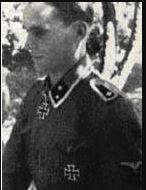Biegi, Fritz (Waffen SS)
- Date of birth:
- January 8th, 1918 (Bechtheim/Hesse, Germany)
- Date of death:
- March 16th, 1945 (north of Leobschütz/Silesia, Germany)
- Buried on:
- German War Cemetery Groß Nädlitz
- Service number:
- SS-Nr.: // NSDAP-Nr.:
- Nationality:
- German
Biography
Promotions:
01.01.1941: SS-Unterscharführer
01.12.1942: SS-Oberscharführer
00.00.1944: SS-Standarten-Oberjunker
Career:
01.11.1937-28.03.1938: Reichsarbeitsdienst
01.04.1938: 7. Sturm, SS-Standarte „Germania"
14.06.1941: SS-Unterscharführer, 7. Kompanie, SS-Regiment (mot.) „Germania"
22.10.1943: 5. Kompanie, SS-Panzergrenadier-Regiment 9 „Germania"
00.06.1944: SS-Oberscharführer, Zugführer, 5. Kompanie, SS-Panzergrenadier-Regiment 9 „Germania"
16.03.1945: SS-Standarten-Oberjunker, Stab, SS-Panzergrenadier-Regiment 39, 18. SS-Freiwilligen-Panzergrenadier-Division „Horst Wessel", KIA near Langlieben-Kreuzlinden, Leobschütz
Do you have more information about this person? Inform us!
- Period:
- Second World War (1939-1945)
- Awarded on:
- July 14th, 1941
- Period:
- Second World War (1939-1945)
- Awarded on:
- February 18th, 1942
- Period:
- Second World War (1939-1945)
- Awarded on:
- 1942
- Period:
- Second World War (1939-1945)
- Awarded on:
- October 16th, 1942
- Period:
- Second World War (1939-1945)
- Awarded on:
- April 1st, 1943
- Period:
- Second World War (1939-1945)
- Rank:
- SS-Oberscharführer (Staff Sergeant)
- Unit:
- Zugführer, 5. Kompanie, SS-Panzer-Grenadier-Regiment 9, 5. SS-Panzer-Division
- Awarded on:
- June 16th, 1944
“SS-Oberscharführer Biege has outstandingly distinguished himself as a patrol leader on many battlefields of this war. In uncounted engagements he has provided ample evidence of his courage, decisiveness and model readiness for duty. He is possessed of a fanatical spirit in both attack and defense, and the shining example he has provided for his men has inspired them to their highest achievements.
His finest hour would be on the 01.02.1944. The Regiment was deployed for the defense of the city of Orlowez (20 km west of Ssmela). The defense of this sector was made rather difficult by the rugged and ravine covered landscape. The terrain that sloped from the east to west culminated in Point 204.7, the hill upon which Biegi’s Zug was positioned.
Observation and reconnaissance throughout the day had determined that the enemy would pursue the Regiment’s withdrawal movement from the Irdym river to the Orlowez sector with speed and surprise. It was expected that they would launch reconnaissance probes during the night and then a major attack on the 02.02.1944.
A storm set in during the evening, making hearing very difficult. Being heavily aided by these conditions, the enemy already commenced an attack with strong forces against Hill 204.7 at around 20:00 on the 01.02.1944. (The enemy strength was later estimated to be 500 men).
The massive enemy infantry thrust crashed against the right wing of Biegi’s Zug. The enemy achieved a penetration following bitter close combat, and after this they immediately sought to expand it with follow-on infantry. The enemy objective was to thrust through Orlowez to Gorodischtsche, and by continuing their attack they would ultimately divide the pocket west of Cherkassy. The loss of Hill 204.7 would have resulted in the collapse of the defensive front in the Orlowez sector.
Immediately recognizing the gravity of the situation, Biegi stormed to the point of penetration with 2 messengers. He took an MG from the hands of a wounded soldier and brought it to bear against a not-yet deployed enemy infantry gun platoon.
Biegi opened fire from a range of 20 metres, firing his MG from the hip and slaying the enemy gun crews. Biegi immediately destroyed the three guns with hand grenades. Using hastily assembled elements of his Zug he then cleared the break-in point at an ever increasing rate. He rolled it up from the north to south and reestablished contact with the right and left neighbours.
Through this determined action, Biegi prevented an influx of additional enemy infantry and cut off those hostile elements already moving towards Orlowez. Biegi defended the bitterly contested hill over the course of 12 hours of ferocious combat against ever oncoming infantry masses and smaller assault units that came from both without and within. He did so until the morning of the 02.02.1944, by which time the broken-in enemy elements had finally been eliminated by friendly reserves and new forces had been inserted into the main line of defense.
On the 02.02.1944 a total of well over 100 enemy dead were counted on the battlefield. 3 infantry guns, 10 MGs, 6 mortars and innumerable small-arms were captured. 40 prisoners were also brought in.
This outstanding deed by SS-Oberscharführer Biegi was of battle-deciding importance for the hard-pressed infantry formations in the pocket west of Cherkassy.
The Regiment believes Biegi to be worthy of bearing the Knight’s Cross of the Iron Cross.”
Sources
- Photo 1:
- - THOMAS, FRANZ & WEGMANN, GüNTER, Die Ritterkreuzträger der Deutschen Wehrmacht 1939-1945, Biblio Verlag, Osnabrück, 1992.
- Die Ordensträger der Deutschen Wehrmacht (CD), VMD-Verlag GmbH, Osnabrück, 2002
- Fellgiebel W.P., Elite of the Third Reich, The recipients of the Knight's Cross of the Iron Cross 1939-1945: A Reference, Helion & Company Limited, Solihull, 2003, ISBN 1-874622-46-9








